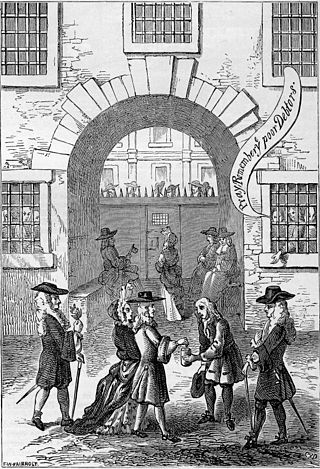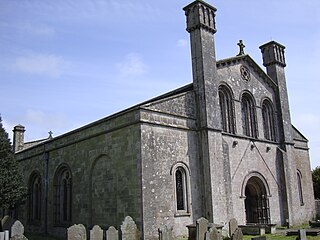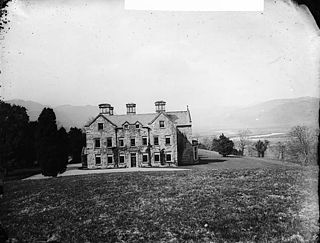Related Research Articles

Fleet Prison was a notorious London prison by the side of the River Fleet. The prison was built in 1197, was rebuilt several times, and was in use until 1844. It was demolished in 1846.

Lady Charlotte Elizabeth Guest, later Lady Charlotte Schreiber, was an English aristocrat who is best known as the first publisher in modern print format of the Mabinogion, the earliest prose literature of Britain. Guest established the Mabinogion as a source literary text of Europe, claiming this recognition among literati in the context of contemporary passions for the chivalric romance of King Arthur and the Gothic movement. The name Guest used for the book was derived from a mediaeval copyist's error, already established in the 18th century by William Owen Pughe and the London Welsh societies.

The Red Book of Hergest, Oxford, Jesus College, MS 111, is a large vellum manuscript written shortly after 1382, which ranks as one of the most important medieval manuscripts written in the Welsh language. It preserves a collection of Welsh prose and poetry, notably the tales of the Mabinogion and Gogynfeirdd poetry. The manuscript derives its name from the colour of its leather binding and from its association with Hergest Court between the late 15th and early 17th century.

Edward Williams, better known by his bardic name Iolo Morganwg, was a Welsh antiquarian, poet and collector. He was seen as an expert collector of Medieval Welsh literature, but it emerged after his death that he had forged several manuscripts, notably some of the Third Series of Welsh Triads. Even so, he had a lasting impact on Welsh culture, notably in founding the secret society known as the Gorsedd, through which Iolo Morganwg successfully co-opted the 18th-century Eisteddfod revival. The philosophy he spread in his forgeries has had an enormous impact upon neo-Druidism. His bardic name is Welsh for "Iolo of Glamorgan".

The White Book of Rhydderch is one of the most notable and celebrated surviving manuscripts in Welsh. Mostly written in southwest Wales in the middle of the 14th century it is the earliest collection of Welsh prose texts, though it also contains some examples of early Welsh poetry. It is now part of the collection of the National Library of Wales, having been preserved in the library at Hengwrt, near Dolgellau, Gwynedd, of the 17th century antiquary Robert Vaughan, who inherited it from the calligrapher John Jones and passed it to his descendants. The collection later passed to the newly established National Library of Wales as the Peniarth or Hengwrt-Peniarth Manuscripts.
Côr Tewdws or Bangor Tewdws is a fictional Romano-British ecclesiastical college that in the 18th and 19th centuries was understood to have been the predecessor of the historically attested 6th century College and Abbey of Saint Illtud at what is now Llantwit Major in Glamorgan in Wales. The supposed Roman college is believed to have been invented by the historian of ill-repute, Edward Williams, more generally known as Iolo Morganwg.

William Owen Pughe was a Welsh antiquarian and grammarian best known for his Welsh and English Dictionary, published in 1803, but also known for his grammar books and "Pughisms" (neologisms).
This article is about the particular significance of the century 1601–1700 to Wales and its people.
Robert Powell Vaughan was an eminent Welsh antiquary and collector of manuscripts. His collection, later known as the Hengwrt–Peniarth Library from the houses in which it was successively preserved, formed the nucleus of the National Library of Wales, and is still in its care.

Anwyl of Tywyn are a Welsh family who claim a patrilinear descent from Owain Gwynedd, King of Gwynedd from 1137 to 1170 and a scion of the royal House of Aberffraw. The family motto is: Eryr eryrod Eryri, which translates as "The Eagle of the Eagles of Snowdonia. The family lives in Gwynedd and speak Welsh.
Richard Thomas was a Welsh Anglican priest and antiquarian.
The Myvyrian Archaiology of Wales is a printed collection of medieval Welsh literature, published in three volumes by the Gwyneddigion Society between 1801 and 1807. Until John Gwenogvryn Evans produced diplomatic editions of the important medieval Welsh manuscripts, the Myvyrian Archaiology provided the source text for many translators of medieval Welsh material. It was founded, and funded, by Owen Jones, who engaged William Owen Pughe as editor, and Edward Williams, better known as Iolo Morganwg, to search Wales for manuscripts.

The White Book of Hergest was an important Welsh manuscript compiled in c. 1450. It contained many Welsh poems and prose texts and was a significant source for several antiquaries of the 17th and 18th centuries, but disappeared in the early 19th century, probably being destroyed in a fire in a London bookbinder's shop in around 1810.
Robert ap Huw, was a Welsh harpist and music copyist. He is most notable for compiling a manuscript, now known as the Robert ap Huw manuscript, which is the main extant source of cerdd dant and is a late medieval collection of harp music. It is one of the most important sources of early Welsh music.

The Coelbren y Beirdd is a script created in the late eighteenth century by the Welsh antiquarian and literary forger Edward Williams, best known as Iolo Morganwg.
William Maurice (1620–1680) was a well-known seventeenth-century collector and transcriber of Welsh manuscripts and books from Denbighshire, Wales.

Hengwrt was a mansion near Dolgellau in Meirionnydd, Gwynedd. It lay in the parish of Llanelltyd near the confluence of the River Mawddach and River Wnion, near Cymer Abbey. With medieval origins, it was rebuilt or remodelled on several occasions before being demolished in 1962. It is remembered as the original home of the important collection of the Peniarth Manuscripts, now in the National Library of Wales.
Meurig Dafydd was a Welsh bard, genealogist and historian, at one time one of the leading literary figures in Glamorgan. However, his poetry was formal and uninspired.
Thomas Wiliems was a Welsh-language antiquarian.
References
- ↑ Plough Inn Archived 20 July 2011 at the Wayback Machine , Discovering Shropshire's History
- 1 2 3 4 5 John Jones of Gellilyfdy, Dictionary of Welsh Biography, National Library of Wales
- ↑ MS. Peniarth 315 (Hengwrt 520), 32
- ↑ Heinz, S. Welsh dictionaries in the twentieth century: a critical analysis, Lincom, 2002, p.150
- ↑ Pughe, W. O. Dictionary of the Welsh Language: explained in English, v.1, 1832, p. x